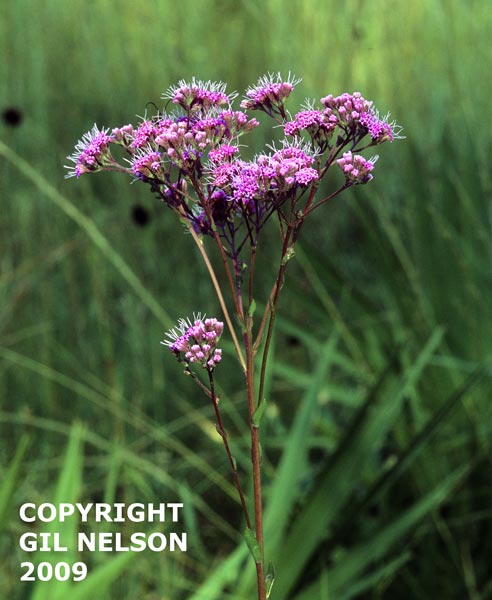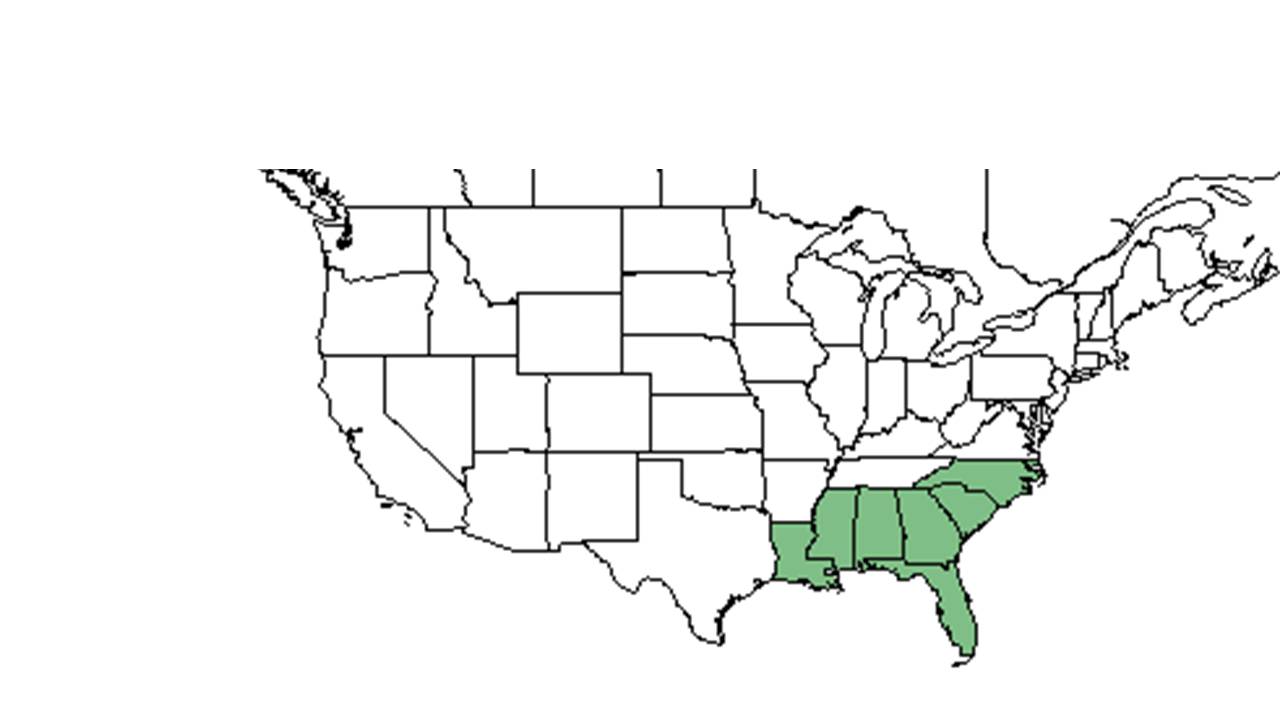Difference between revisions of "Trilisa odoratissima"
Lsandstrum (talk | contribs) |
|||
| Line 29: | Line 29: | ||
==Ecology== | ==Ecology== | ||
===Habitat=== <!--Natural communities, human disturbed habitats, topography, hydrology, soils, light, fire regime requirements for removal of competition, etc.--> | ===Habitat=== <!--Natural communities, human disturbed habitats, topography, hydrology, soils, light, fire regime requirements for removal of competition, etc.--> | ||
| − | It is found in frequently burned pine flatwoods or dry prairies <ref name="Carrington et al 2013">Carrington, M. E. and J. J. Mullahey (2013). "Saw palmetto (Serenoa repens) flowering and fruiting response to time since fire." Rangeland Ecology & Management 66: 43-50.</ref> and moist areas, depressions, and seepages within burned upland longleaf pine-wiregrass communities <ref name="Kirkman et al 1998">Kirkman, L. K., M. B. Drew, et al. (1998). "Effects of experimental fire regimes on the population dynamics of Schwalbea americana L." Plant Ecology 137: 115-137.</ref> and oak-pine woodlands on Ultisols, as well as sand ridges within flatwoods and pine-saw palmettos. <ref name="FSU Herbarium">Florida State University Robert K. Godfrey Herbarium database. URL: [http://herbarium.bio.fsu.edu http://herbarium.bio.fsu.edu]. Last accessed: June 2014. Collectors: L. C. Anderson, E. L. Bridges, E. H. Butts, A. F. Clewell, R. K. Godfrey, R. D. Houk, R. Komarek, R. Kral, R. L. Lazor, J. Morrill, R. A. Norris, S. L. Orzell, J. D. Ray Jr., P. L. Redfearn Jr., V. I. Sullivan and R. White. States and Counties: Florida: Bay, Duval, Escambia, Franklin, Gadsden, Gulf, Holmes, Jefferson, Lafayette, Leon, Liberty, Madison, Nassau, Okaloosa, Pasco, Polk, Putnam, Santa Rosa, Taylor, Wakulla, and Walton. Georgia: Grady and Thomas.</ref> It was absent from the seed bank in disturbed and undisturbed sites in North Carolina. <ref name="Cohen et al 2004">Cohen, S., R. Braham, et al. (2004). "Seed bank viability in disturbed longleaf pine sites." Restoration Ecology 12: 503-515.</ref> It occurs primarily on sandy and drying loamy soils. <ref name="FSU Herbarium"/> It is found in disturbed areas such as roadsides, fields, and ditches as well as undisturbed sites. <ref name="Cohen et al 2004"/> <ref name="FSU Herbarium"/> Associated species include ''Quercus, Pinus, Pinus elliottii, Sabal palmetto'', and ''Aristida stricta.'' <ref name="FSU Herbarium"/> | + | It is found in frequently burned pine flatwoods or dry prairies <ref name="Carrington et al 2013">Carrington, M. E. and J. J. Mullahey (2013). "Saw palmetto (Serenoa repens) flowering and fruiting response to time since fire." Rangeland Ecology & Management 66: 43-50.</ref> and moist areas, depressions, and seepages within burned upland longleaf pine-wiregrass communities <ref name="Kirkman et al 1998">Kirkman, L. K., M. B. Drew, et al. (1998). "Effects of experimental fire regimes on the population dynamics of Schwalbea americana L." Plant Ecology 137: 115-137.</ref> and oak-pine woodlands on Ultisols, as well as sand ridges within flatwoods and pine-saw palmettos. <ref name="FSU Herbarium">Florida State University Robert K. Godfrey Herbarium database. URL: [http://herbarium.bio.fsu.edu http://herbarium.bio.fsu.edu]. Last accessed: June 2014. Collectors: L. C. Anderson, E. L. Bridges, E. H. Butts, A. F. Clewell, R. K. Godfrey, R. D. Houk, R. Komarek, R. Kral, R. L. Lazor, J. Morrill, R. A. Norris, S. L. Orzell, J. D. Ray Jr., P. L. Redfearn Jr., V. I. Sullivan and R. White. States and Counties: Florida: Bay, Duval, Escambia, Franklin, Gadsden, Gulf, Holmes, Jefferson, Lafayette, Leon, Liberty, Madison, Nassau, Okaloosa, Pasco, Polk, Putnam, Santa Rosa, Taylor, Wakulla, and Walton. Georgia: Grady and Thomas.</ref> It was absent from the seed bank in disturbed and undisturbed sites in North Carolina. <ref name="Cohen et al 2004">Cohen, S., R. Braham, et al. (2004). "Seed bank viability in disturbed longleaf pine sites." Restoration Ecology 12: 503-515.</ref> It occurs primarily on sandy and drying loamy soils. <ref name="FSU Herbarium"/> It is found in disturbed areas such as roadsides, fields, and ditches as well as undisturbed sites. <ref name="Cohen et al 2004"/> <ref name="FSU Herbarium"/> ''T. odoratissima'' does not respond to soil disturbance by clearcutting and chopping in North Florida flatwoods forests.<ref>Moore, W.H., B.F. Swindel, and W.S. Terry. (1982). Vegetative Response to Clearcutting and Chopping in a North Florida Flatwoods Forest. Journal of Range Management 35(2):214-218.</ref> |
| + | |||
| + | Associated species include ''Quercus, Pinus, Pinus elliottii, Sabal palmetto'', and ''Aristida stricta.'' <ref name="FSU Herbarium"/> | ||
''Trilisa odoratissima'' is restricted to native groundcover with a statistical affinity in upland pinelands of South Georgia. <ref name="Ostertag and Robertson 2007">Ostertag, T.E., and K.M. Robertson. 2007. A comparison of native versus old-field vegetation in upland pinelands managed with frequent fire, South Georgia, USA. Pages 109–120 in R.E. Masters and K.E.M. Galley (eds.). Proceedings of the 23rd Tall Timbers Fire Ecology Conference: Fire in Grassland and Shrubland Ecosystems.</ref> While this species is found in the uplands, it is found in the lowlands as well (FSU Herbarium). | ''Trilisa odoratissima'' is restricted to native groundcover with a statistical affinity in upland pinelands of South Georgia. <ref name="Ostertag and Robertson 2007">Ostertag, T.E., and K.M. Robertson. 2007. A comparison of native versus old-field vegetation in upland pinelands managed with frequent fire, South Georgia, USA. Pages 109–120 in R.E. Masters and K.E.M. Galley (eds.). Proceedings of the 23rd Tall Timbers Fire Ecology Conference: Fire in Grassland and Shrubland Ecosystems.</ref> While this species is found in the uplands, it is found in the lowlands as well (FSU Herbarium). | ||
Revision as of 19:30, 23 July 2019
| Trilisa odoratissima | |
|---|---|

| |
| Photo taken by Gil Nelson | |
| Scientific classification | |
| Kingdom: | Plantae |
| Division: | Magnoliophyta - Flowering plants |
| Class: | Magnoliopsida – Dicotyledons |
| Order: | Asterales |
| Family: | Asteraceae ⁄ Compositae |
| Genus: | Trilisa |
| Species: | T. odoratissima |
| Binomial name | |
| Trilisa odoratissima (J.F. Gmel.) Herb. | |

| |
| Natural range of Trilisa odoratissima from USDA NRCS Plants Database. | |
Common names: Vanillaleaf, Deer's-tongue
Contents
Taxonomic notes
Synonyms: Carphephorus odoratissimus; Carphephorus odoratissimus (J.F. Gmelin) Herbert var. odoratissimus; Trilisa odoratissima var. odoratissima
Description
A description of Trilisa odoratissima is provided in The Flora of North America.
Distribution
Ecology
Habitat
It is found in frequently burned pine flatwoods or dry prairies [1] and moist areas, depressions, and seepages within burned upland longleaf pine-wiregrass communities [2] and oak-pine woodlands on Ultisols, as well as sand ridges within flatwoods and pine-saw palmettos. [3] It was absent from the seed bank in disturbed and undisturbed sites in North Carolina. [4] It occurs primarily on sandy and drying loamy soils. [3] It is found in disturbed areas such as roadsides, fields, and ditches as well as undisturbed sites. [4] [3] T. odoratissima does not respond to soil disturbance by clearcutting and chopping in North Florida flatwoods forests.[5]
Associated species include Quercus, Pinus, Pinus elliottii, Sabal palmetto, and Aristida stricta. [3]
Trilisa odoratissima is restricted to native groundcover with a statistical affinity in upland pinelands of South Georgia. [6] While this species is found in the uplands, it is found in the lowlands as well (FSU Herbarium).
Phenology
It has been seen flowering September through November and fruiting in October through November. [3]
Fire ecology
It is fire-tolerant. [4] T. odoratissima was a prevalent species on burned plots. [7]
Pollination
The following Hymenoptera families and species were observed visiting flowers of T odoratissima at Archbold Biological Station: [8]
Apidae: Bombus pennsylvanicus
Halictidae: Augochlorella aurata, Halictus poeyi
Megachilidae: Coelioxys octodentata, C. sayi, Dianthidium floridiense, Megachile albitarsis, M. inimica
Conservation and management
Cultivation and restoration
Photo Gallery
References and notes
- ↑ Carrington, M. E. and J. J. Mullahey (2013). "Saw palmetto (Serenoa repens) flowering and fruiting response to time since fire." Rangeland Ecology & Management 66: 43-50.
- ↑ Kirkman, L. K., M. B. Drew, et al. (1998). "Effects of experimental fire regimes on the population dynamics of Schwalbea americana L." Plant Ecology 137: 115-137.
- ↑ 3.0 3.1 3.2 3.3 3.4 Florida State University Robert K. Godfrey Herbarium database. URL: http://herbarium.bio.fsu.edu. Last accessed: June 2014. Collectors: L. C. Anderson, E. L. Bridges, E. H. Butts, A. F. Clewell, R. K. Godfrey, R. D. Houk, R. Komarek, R. Kral, R. L. Lazor, J. Morrill, R. A. Norris, S. L. Orzell, J. D. Ray Jr., P. L. Redfearn Jr., V. I. Sullivan and R. White. States and Counties: Florida: Bay, Duval, Escambia, Franklin, Gadsden, Gulf, Holmes, Jefferson, Lafayette, Leon, Liberty, Madison, Nassau, Okaloosa, Pasco, Polk, Putnam, Santa Rosa, Taylor, Wakulla, and Walton. Georgia: Grady and Thomas.
- ↑ 4.0 4.1 4.2 Cohen, S., R. Braham, et al. (2004). "Seed bank viability in disturbed longleaf pine sites." Restoration Ecology 12: 503-515.
- ↑ Moore, W.H., B.F. Swindel, and W.S. Terry. (1982). Vegetative Response to Clearcutting and Chopping in a North Florida Flatwoods Forest. Journal of Range Management 35(2):214-218.
- ↑ Ostertag, T.E., and K.M. Robertson. 2007. A comparison of native versus old-field vegetation in upland pinelands managed with frequent fire, South Georgia, USA. Pages 109–120 in R.E. Masters and K.E.M. Galley (eds.). Proceedings of the 23rd Tall Timbers Fire Ecology Conference: Fire in Grassland and Shrubland Ecosystems.
- ↑ Kush, J. S., R. S. Meldahl, et al. (1999). "Understory plant community response after 23 years of hardwood control treatments in natural longleaf pine (Pinus palustris) forests." Canadian Journal of Forest Research 29: 1047-1054.
- ↑ Deyrup, M.A. 2015. Database of observations of Hymenoptera visitations to flowers of plants on Archbold Biological Station, Florida, USA.